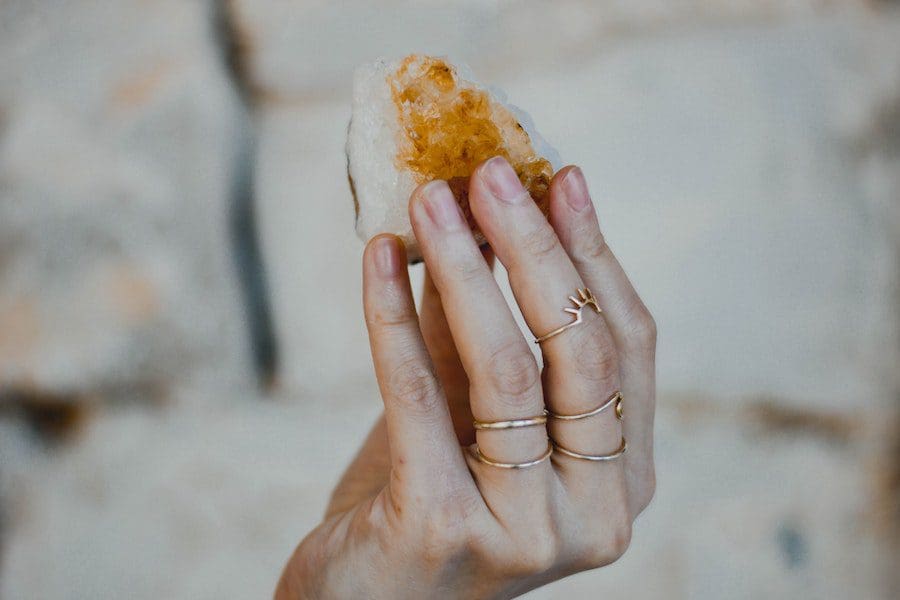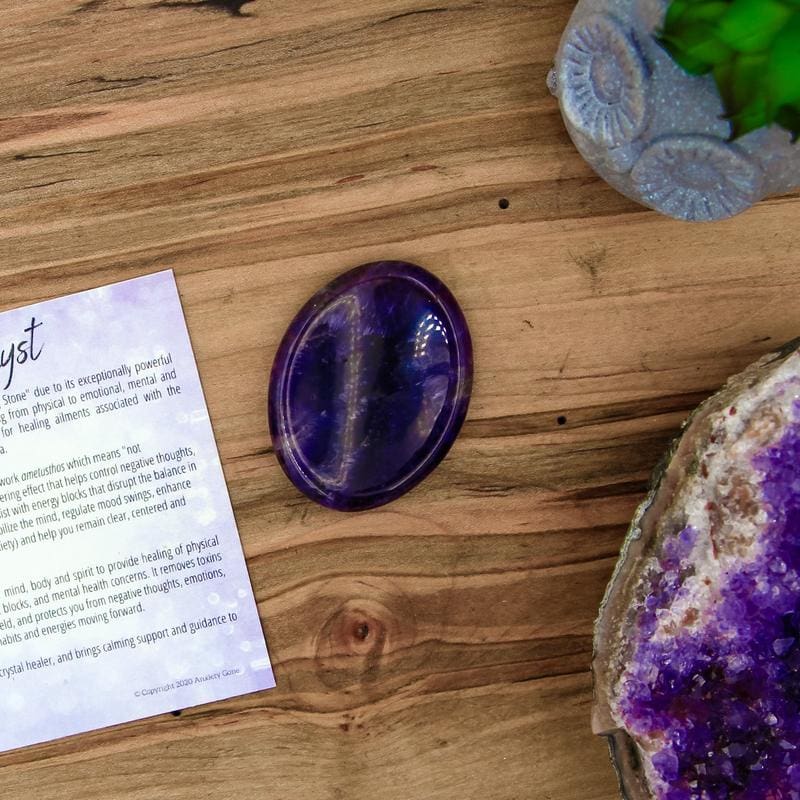Full Disclosure: Clicking on these links could mean a tiny commission for me, at no extra cost to you.
By now, you’ve probably heard about worry stones and how they can help alleviate anxiety and panic attacks. Worry stones are a favourite coping tool that allows you to distract your mind away from the anxious thoughts as soon as they come. They’re a top seller in our mental wellness store because they’re affordable, effective, discrete and perfect for all ages. But there’s far more magic that comes with worry stones and that’s what we’re going to dive into today.
What are Worry Stones?
First things first, let’s talk about what worry stones are. Also known as ‘thumb stones’, worry stones are small, often oval-shaped stones for anxiety that have an indent in the center for your thumb. These are shaped either by nature or human. The object of these thumb stones is to provide you with a tool that you can use to calm down when you’re feeling anxious, stressed, overwhelmed, need help focusing. They’re much like similar stress relief items such as stress balls, and fidget cubes, only more subtle, less-distracting for others and super chic.
Where Do Worry Stones Come From?
The Anxiety Gone shop, of course! These beautiful crystals for anxiety have been used for centuries. The exact origin isn’t but worry stones have been found all over the world and well throughout history. It is believed that these thumb stones were inspired by the monks, who would have a rock with them while they meditated. Overtime, the rocks began to form an indentation from where their thumb was placed. Don’t worry – our collection of anxiety thumb stones come pre-made with the indentation for your thumb.
The Ancient Greeks are also said to have pulled stones from the sea and used them as a self soothing mechanism. Other reports show that Indigenous peoples held onto the stones and passed them on from generation to generation. Worry stones have also been found long ago in Tibet and Ireland, as well as in almost every culture around the world.
How Do Thumb Stones Work?
Thumb stones work in a variety of ways that are particularly beneficial for anyone struggling with high stress, anxiety, ADHD, fidgeting, picking, and focusing. The texture of the stone combined with the rubbing motion of the thumb is believed to naturally calm stress and anxiety. By focusing on the motion, texture and appearance, you can distract your brain away from your anxious thoughts and narrow in on a task that you’re trying to focus on. It’s also believed that thumb stones activate energy points in your finger to promote calmness, release feel-good endorphins, and to provide you with an overall euphoric effect.
Benefits of Using Worry Stones for Anxiety
The benefits of using stones for anxiety are vast and they don’t have to be thumb stones – any crystals work. However, the indentation in these crystals are certainly a key factor that makes them such a powerful tool for overcoming anxiety. From the physical touch stimulation to activating acupressure points, these are the top benefits that have made thumb stones a must-have self-soothing tool.
Coping with Stress and Anxiety
The top benefit of using a worry stone is stress relief. By rubbing the gemstones, you create a pleasant sensation that provides sensory stimulation that takes your mind away from the anxiety (or ADD/ADHD) that is disrupting your day. The acupressure points in your thumb are also activated and said to bring a positive, euphoric experience. This is a common reflexology practice, but one that you can do at home, on-the-go and without a professional therapist.
Redirect Destructive Repetitive Behaviours
Touch stimulation has been proven to be a therapeutic activity that can do everything from relieving pain to rewiring the brain to remove repetitive behaviours, such as nail biting or skin picking. The unique thing about using gemstones for touch stimulation is that they’re super subtle, lightweight and can be used without distracting those around you. So, the next time you feel triggered to pick, grab your worry stone and see how it satisfies this urge in a more positive way.
Distraction From Worry
Worrying is a constant when you have anxiety. It can take over your mind, making it difficult to focus on the task at hand. Rubbing a thumb stone can help you narrow in your focus on the present moment (and task) that needs to be completed. As you use the worry stone, your worries will slowly fade into the back so you can get back to doing what it was you were doing before intrusive, worrying thoughts started to take over.
The stone is easy to use in any situation. You simply carry it with you in your pocket, purse, or wallet and rub it whenever you like. You don’t have to learn any complex techniques to use it – just rub it between your thumb and forefingers. Worry stones have been used in many situations in a variety of ways, as well. Below are a few examples.
Visual Reminder of Your Intention
Assigning a mantra, affirmation or intention to your worry stones can provide you with a visual reminder of what it is you’re trying to do anytime you see or hold your stone. Your intention may be to ground yourself, redirect negative thought loops or to take long, deep breaths.
Recognizing Anxiety Levels and Triggers
A top benefit of using thumb stones for anxiety relief is that they can help you recognize your anxiety levels and triggers. In one study aimed at measuring engagement with therapy, worry stones were used during therapy sessions to gauge the participant’s levels of anxiety. You can also use this soothing technique yourself simply by taking notice of how often you use your thumb stones and what situations you use them in the most. This will help you identify triggers and patterns, which can help you cope with anxiety in future situations.
Promoting Energy Healing
Many people choose to use gemstone worry stones over the other varieties, for an extra dose of anxiety relief and energetic healing. These types of stones hold energetic vibrations that can help you achieve what it is you’re looking for. For example, in Native American culture, a quartz worry stone is seen as an extremely soothing stone. Each stone has its own healing properties, offering a new realm of anxiety relief that goes far beyond what meets the eye (and touch). Here are some of our top worry stones for anxiety:
- Rose quartz – for overcoming emotional trauma and give you the love and nurturing you need
- Obsidian – for keeping you in the clear of negative emotions and negative energy
- Tiger’s eye – for releasing fear and anxiety and to stimulate taking action
- Amethyst – for soothing stress, irritability, mood swings, anger, fear and insomnia
- White howlite – for unburdening an overactive mind
- Lepidolite – for halting obsessive thoughts, stabilising mood swings and creating a calm sensation
- Rhodonite – for clearing away emotional wounds and scars from the past
- Unakite – for relieving stress and depression and calming sensitive emotions
- African bloodstone – for extra layer of emotional and mental protection
- Jasper – for supporting you through times of stress and anxiety
- Aventurine – for attracting great things into your life
How To Use A Worry Stone
To harness the benefits of a worry stone, you simply hold the stone and press your thumb into the indentation. You can rub the indentation, squeeze it tightly in your hand or rub the stone with your fingers. It’s incredibly easy, making it the perfect coping mechanisms for any age and for any situation that’s triggering your anxiety. To enhance your experience, you can combine the use of a thumb stone with an intention, positive affirmation, mantra or focused thought.
Learning how to overcome anxiety or at the very least, stop it from disrupting your life will likely take more than a worry stone. These gemstones are not designed to make your trauma, crisis or limited beliefs disappear. Instead, they help you navigate through those difficult situations so that you can maintain control even when anxiety arises. For getting down to the root cause of your anxiety so you can finally be free of it, there are many other options that can help, such as meditation, regular exercise, clean eating and attending online therapy.
This blog post is sponsored by BetterHelp, but all opinions are my own. We may receive compensation from BetterHelp or other sources if you purchase products or services through the links provided on this page.












